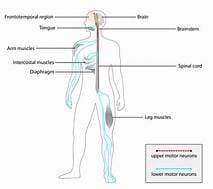Amyotrophic Lateral Sclerosis (ALS), commonly known as Lou Gehrig’s disease, is a formidable adversary that silently infiltrates the nervous system, relentlessly affecting nerve cells in the brain and spinal cord. Let us delve into the intricacies of this enigmatic condition.
1. What Is ALS?
ALS is a neuromuscular disorder characterized by the gradual degeneration of motor neurons—the nerve cells responsible for controlling voluntary muscles. Both upper motor neurons (extending from the brain to the spinal cord) and lower motor neurons (extending from the spinal cord to muscles throughout the body) are affected. As these neurons wither away, they cease to send vital messages to the muscles, leading to muscle weakness and loss of control.

2. Symptoms and Progression
The symptoms of ALS vary from person to person, but they all share a common thread of physical decline. Here are some hallmark signs:
- Muscle Weakness: It often begins in the hands, feet, arms, or legs and gradually spreads. Walking becomes challenging, and daily activities become arduous.
- Speech and Swallowing Difficulties: Slurred speech and trouble swallowing are early indicators.
- Motor Control Loss: As the disease progresses, it affects the muscles needed for movement, speech, eating, and breathing.
- Emotional Outbursts: Untimely crying, laughing, or yawning may occur.
- Thinking and Behavioral Changes: ALS can impact cognitive functions.
Remarkably, ALS doesn’t typically cause pain, and it rarely affects bladder control or sensory perception (taste, smell, touch, and hearing).
3. The Mysterious Cause
The exact cause of ALS remains elusive. While approximately 10% of cases have a genetic component, the majority remain idiopathic—without a known cause. Researchers continue to explore potential triggers, but the veil of mystery persists.
4. Living with ALS
Living with ALS is an uphill battle. There is no cure for this relentless disease. However, treatments focus on managing symptoms and enhancing quality of life. Therapies, medications, and assistive devices play a crucial role in supporting individuals with ALS.
5. The Legacy of Lou Gehrig
The disease is forever linked to the iconic baseball player Lou Gehrig, who faced ALS with courage and grace. His farewell speech, delivered at Yankee Stadium in 1939, remains etched in history: “Today, I consider myself the luckiest man on the face of the earth.” Gehrig’s resilience and advocacy continue to inspire those affected by ALS.
6. Kenneth Mitchell:-
At the age of 49, Kenneth Mitchell, the gifted actor best recognised for his roles in “Star Trek” and “Captain Marvel,” died on Saturday. Many people were moved by his fight against the debilitating neurological disease ALS (Amyotrophic Lateral Sclerosis).
7. Kenneth Mitchell’s ALS Journey:-
Kenneth Mitchell’s journey started over five years ago when he was given the diagnosis that would change his life. Lou Gehrig’s disease, also known as ALS, destroys the nerve cells in the upper and lower bodies that control muscle function. There are serious physical limits as a result of these cells’ inevitable death and progressive malfunction.
In conclusion, ALS is a silent adversary—one that robs individuals of their physical abilities while leaving their minds intact. As we strive for answers and advancements, let us honor the courage of those who battle this formidable foe every day.


